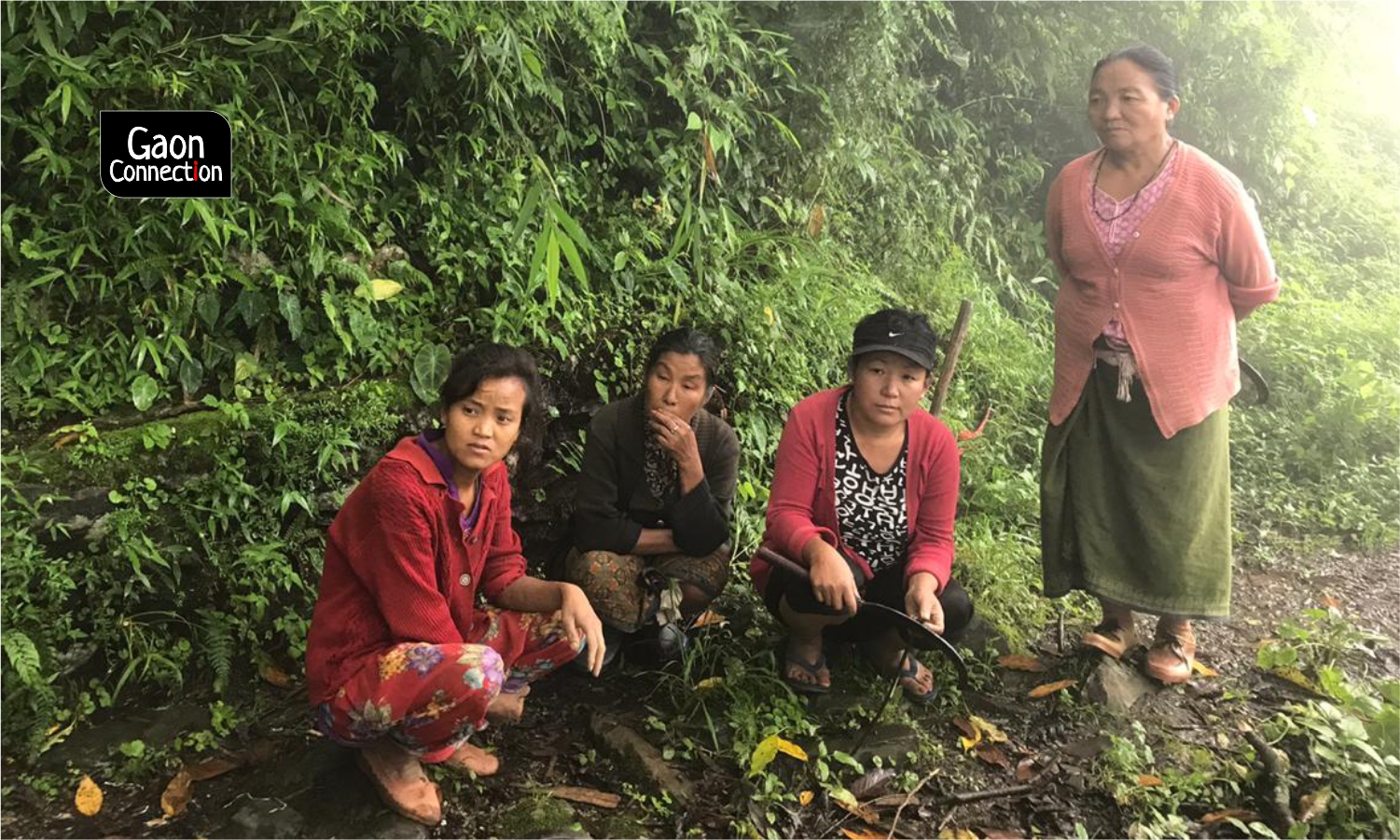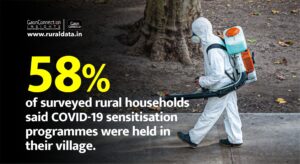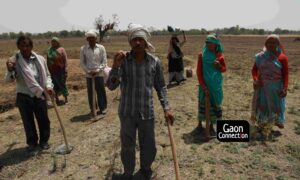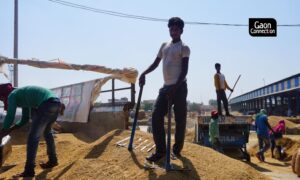Twenty-eight-year-old Martin Kaipeng used to work as a captain in a restaurant in one of Chennai’s suburban areas. After the novel coronavirus disease (COVID-19) induced lockdown, the proprietor was unable to pay him. Kaipeng, originally from Santang Para No 2 village in Amarpur district of South Tripura, around 3,000 kilometers (km) from Chennai, stayed on, hoping things would improve. Finally, in May, he got to know of the Shramik trains leaving for Agartala. Their train on May 19 got cancelled, and Kaipeng, his pregnant sister and his friends were on the streets. They had vacated the place they lived in all these years. Finally, a group helping migrant workers supported them, and they found food and shelter till they boarded the train on May 25. He reached his village on May 29.
However, surviving in the village has been as arduous as the journey back home. “I came back as my salary was not being paid and my sister found it difficult to get medical treatment. Waise bhi ham log Northeast se hai, to log hame China China bulate hai (As we are from the Northeast and because of our physical features, they call us Chinese),” Kaipeng told Gaon Connection.
Kaipeng is one of the millions of Indians struggling to keep their families afloat. According to Kaipeng, after trekking around 18 km uphill at 7 am, he spends the entire day collecting bamboo — the only source of livelihood available right now — and barely earns Rs 200 to Rs 300 a day by selling it in the local market. With this, he somehow manages two square meals for his family of five. This has been the routine since he returned.
To understand the impact of the COVID-19 lockdown on the rural population of the country, Gaon Connection conducted the first-of-its-kind national survey, across 23 states and three union territories. This included the rural population of five northeastern states — Tripura, Assam, Manipur, Sikkim and Arunachal Pradesh.
Key survey findings of Gaon Connection survey from the Northeast
- In Assam, a whopping 80 per cent of rural respondents did not get work under MGNREGA.
- In Arunachal Pradesh, around 41 per cent of rural respondents went without eating the whole day ‘several times’ during the lockdown.
- In Assam, 87 per cent of rural households went without required medical treatment during the lockdown.
- In Tripura, a whopping 60 per cent of women worked hard to arrange water for their families.
- In Arunachal Pradesh, only 35 per cent of households reported receiving money from the government during the pandemic.
High unemployment, no MGNREGA work
Twenty-eight-year-old Kaipeng presents a grim picture of the unemployment crisis in the northeastern states. “After I came back, I did not get any work in my village and so had to collect bamboo. If you saw our living conditions, you would cry,” he rued.
According to the survey, 74 per cent of the respondent households in Tripura said the unemployment situation in their villages was serious. Moreover, for 66 per cent of the households in the state, making ends meet with household income was ‘extremely’ or ‘quite’ difficult during the lockdown.
Talking about the Mahatma Gandhi National Rural Employment Guarantee Act, 2005 (MGNREGA), which promises work to the rural population, Kaipeng claimed not many people got work under it, as it is not “regular” there.
Of the households surveyed in Tripura, 73 per cent reported that household members did not get work under MGNREGA during the lockdown. In Arunachal Pradesh, this number was 71 per cent. And, a whopping 80 per cent of rural respondents in Assam did not get work under the scheme.
Hunger and reduced access to ration
Amid the scenario of under-nutrition and hunger in the country, the lockdown enforced to contain the spread of COVID-19 seems to have made matters worse. Managing two square meals was hard for a large chunk of rural households, and the northeastern states were no exception.
The survey revealed that around 41 per cent of rural respondents in Arunachal Pradesh went without eating the whole day, several times during the lockdown, followed by Assam at 34 per cent.
Besides, the rural population largely dependent on the public distribution system (PDS) for foodgrains during such distressing times, suffered too. The survey revealed only a little over half of ration card-owning households in Assam received wheat or rice from the government during the lockdown.
Amid the pandemic, it was also found people started spending less on basic items such as atta (flour), dal (pulses) and chawal (rice). In Tripura, 53 per cent of the rural respondents spent less on these during the lockdown, while 44 per cent spent less on biscuits, snacks and sweets during the lockdown. In Arunachal Pradesh, 40 per cent spent less on basic food during the lockdown, while 53 per cent spent less on biscuits, snacks and sweets.
Access to healthcare
Soon after the pandemic hit the country, a large workforce of doctors and health workers, both at the primary and community levels, got “busy” in COVID-19 duties. This shifted focus and ignored the healthcare of millions of people suffering various illnesses, including pregnant women who require constant healthcare, vaccination and prenatal check-ups. According to the survey, around half (45 per cent) of pregnant women in Assam missed out on pre-delivery checks and vaccination during the lockdown.
The survey also tried to ascertain the level of difficulty encountered by rural households with respect to obtaining medicines or seeking medical help during the lockdown. The survey revealed some shocking findings. In Assam, around 9 (87 per cent) in every 10 households went without required medical treatment during the lockdown. This is followed by Arunachal Pradesh at 66 per cent) and Tripura (58 per cent).
Financial distress and debt
As incomes dropped in the lockdown, almost 70 per cent of rural respondents across the country reported high monetary difficulty. Homemaker Hasna Begum, who hails from Dhai Ali village in Sivasagar district of Assam, said her household income dropped as her family’s small business was not functioning like before.
In Assam, 82 per cent of respondents reported that during the lockdown, making ends meet with household income was ‘extremely’ or ‘quite’ difficult. This is followed by Arunachal Pradesh at 68 per cent.
As expected, the debt scenario seems to have gone worse during the lockdown as most economic activities came to a standstill and people had no earning. This forced rural families to borrow money to make both ends meet.
In Assam, 31 per cent borrowed money/took a loan, 16 per cent sold or mortgaged land or jewellery, and 11 per cent sold a prized possession. In Tripura, 13 per cent borrowed money/took a loan, 15 per cent sold or mortgaged land or jewellery, and 20 per cent sold a prized possession.
‘Help’ from the government
To help the poor tide over the COVID-19 crisis, the government on March 26 announced an ex-gratia payment of Rs 500 to be credited to women Jan Dhan account holders for the next three months, beginning April.
Jamini Das, who hails from Taxi Ali village, Sivasagar district, Assam, did not receive this during the lockdown. “I have not received this money. Is the money given at home?” Das asked Gaon Connection. Forget receiving the money, she was not even aware of the scheme. However, Begum said she’d received Rs 500 under the Jan Dhan scheme.
The survey revealed 74 per cent of rural households in Assam reported the government credited money in the bank account of a household member during the lockdown. This is followed by Tripura (61 per cent). Interestingly, only 35 per cent of households in Arunachal Pradesh reported receiving money from the government during the pandemic.
Apart from rural women, the government promised to provide relief to farmers affected due to the lockdown. The Centre said it would transfer the first instalment of Rs 2,000 each of the 86.9 million beneficiaries under the PM Kisan scheme in the first week of April.
Jugal Das, a farmer, who hails from Boniabari village in Sivasagar district, Assam, claimed he had not received any financial assistance from the government, or the assistance of Rs 2,000 under the PM Kisan scheme. “Many so-called farmers who do not even know a thing about farming have received assistance. But I have not received any money,” Das told Gaon Connection.
Water woes
In the last few months, the COVID-19 pandemic has added to the water woes of millions of rural women. To avoid the spread of COVID-19, the government and health agencies recommend frequent handwashing. According to the World Health Organization, washing hands regularly and thoroughly with soap and water kills the viruses that may be on hands.
Women, being the primary providers of water for their families, suffered the direct burden of managing additional water.
Twenty-six-year-old Monika Kaipeng, Martin’s sister, also from Santang Para No 2 village, has to trek 300 metres for water every day. “It becomes difficult to fetch water as the route is hilly. We have to trek seven to eight times every day for water. If a guest comes home, we have to work even harder,” she told Gaon Connection.
According to the survey, a whopping 60 per cent of women in Tripura worked hard to arrange for additional water. Only 39 per cent of the respondents had adequate water in their homes for handwashing.
While 57 per cent of the respondents in Assam claimed to have adequate water in their house for washing hands, 41 per cent said they were working extra hard to arrange water. However, 44 per cent of the respondents in Arunachal Pradesh said they had adequate water in their house for handwashing, and 15 per cent of women worked hard to manage additional water.
Perception of the Modi government
Despite insurmountable suffering during the COVID-19 lockdown, 74 per cent of the rural respondents in the country were ‘satisfied’ with the Narendra Modi government. Respondents in Assam were more likely to think the Modi government was fair in treating the rich and poor equally. Respondents in Arunachal Pradesh were equally likely to think the Modi government was fair and treated the rich and poor equally. Respondents in Tripura were least likely to think the Modi government treated both the rich and poor alike. Similar trends were observed for the government in terms of caring for villages and the cities.
When Kaipeng returned to his village, he was quarantined for 14 days. “We were to get Rs 200 a day and stay in a quarantine centre. We did not get anything. We stayed in a small shed near the field,” he informed. Kaipeng said the only food that came to the centre was home-made and brought by his family, and he ate two meals a day. Interestingly, only 17 per cent respondents in Tripura were satisfied with the panchayat heads’ handling of the outbreak. However, it was rated most positively by the villagers of Assam (57 per cent) and Arunachal Pradesh (44 per cent).
Like Kaipeng, many migrant workers from the northeastern states stranded across the country reached their villages after braving heat and hunger. Even though there are fewer jobs in their villages and just feeding the family is a huge challenge, most pledge to not return to the cities they once headed to for jobs. With no external support, Kaipeng is collecting money to open a small general store in his village. He is hopeful of a new beginning, in his village, in his home.



















